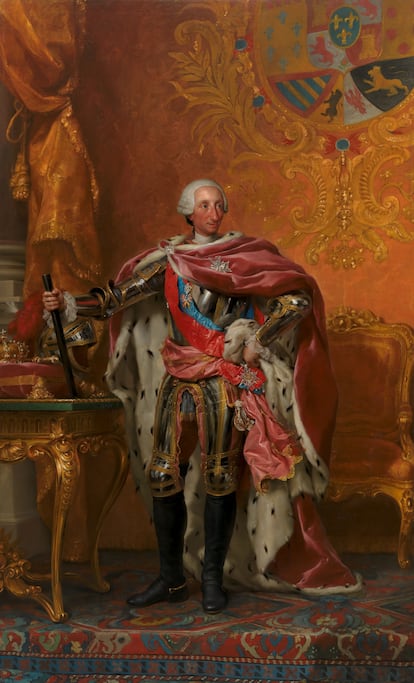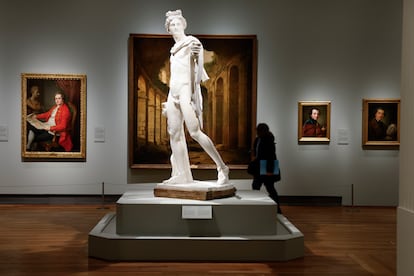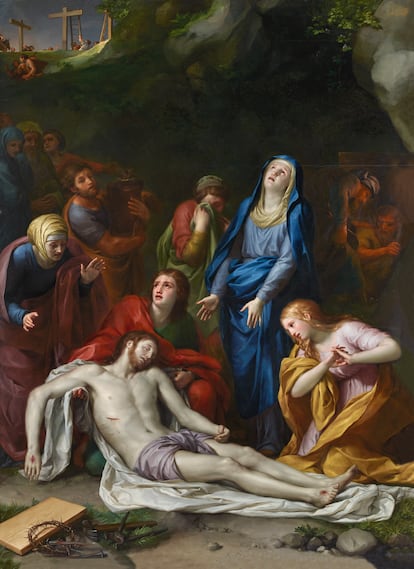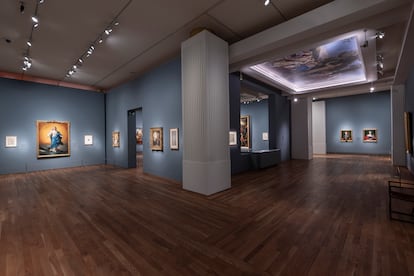
The main exhibitions of the Prado Museum are self-explanatory thanks to the sign at the Jerónimos entrance. But that of Antonio Rafael Mengs required the presentation of fundamental questions and answers, as confessed Andrés Úbeda de los Cobos, head of the Collection of Eighteenth-Century Paintings and Goya and curator of an exhibition that takes its name simply from its protagonist, his own name. First, a statement of intent. Who is Mengs? Why was it important? And why does it deserve this space now? The painter who was instrumental in the birth of Neoclassicism and one of the most influential artists of the 18th century has suffered, the expert assures, an erasure from art history books which has caused his oblivion to spread among academics and the general public. For this reason, they argue from Prado, an exhibition is once again organized around his figure – there are three of them – to remember that, despite his terrible character and dogmatism in the imposition of a canon of pictorial beauty, his figure deserves to be recovered.
Mengs’ life has been marked since his birth by the figure of his father. “The name they impose on you can determine everything,” said Miguel Falomir, director of the museum, at the presentation this Monday, recalling that the author received the names of Antonio Allegri Correggio and Raphael of Urbino, two of the great painters of the Italian Renaissance. From that moment on, as told in the 10 chapters that make up the exhibition with 159 pieces, Mengs’ future was caught between the demands and high expectations placed on him by his father, and those that he himself had imposed on himself. “The way he identified beauty and formal perfection, his technique, made him an obsessive painter,” explained Úbeda de los Cobos. “He said that his works never ended, he continued to the point of desperation, he was always dissatisfied”.
The example is this, Javier Jordán de Urríes, the other curator and conservator of 18th century painting at the National Heritage, also underlined, with his almost transparent brushstrokes, which allowed him to return to them again and again until he achieved the desired effect. It is the enamel with which he finished his works and which now shines in the Prado.
Mengs developed his career between Dresden, Rome and Madrid in an era when what was known as virtuous competitiveness governed the work of artists in European courts. That is, monarchs put large sums of money on the table to get the best artists. Once the offer was accepted, the kings encouraged the most ferocious and voracious of battles between the painters. Toxic dynamics, eminently masculinized, with the ultimate goal of being able to show off the best works of art in front of the rest of the royal family. “Rivalry and competition are extraordinary drivers for promoting talent in the arts,” Falomir said.

In the case of Mengs, Charles III locked him in the Royal Palace to paint, wall after wall, with Tiepolo, at a time, in the mid-18th century, when Madrid was, finally, recognized as the capital of painting on the European circuit. “They were the moon and the sun,” explained the director of the Prado. There are no documents that certify, Falomir recalled, how the monarch contributed to bringing out Mengs’ talent based on pressure and, probably, lies about his colleague’s work, but there is a long tradition of perfecting this technique among monarchs and popes.
If this situation hardened his character, the way in which he laid the foundations of Neoclassicism did not help him make friends among his contemporaries. “He decided to radically change the foundations of European painting, placing classical sculpture and the tradition of the ancient world at the center,” said the curator. “At that time Europeans did not travel to Greece; so his bet lacked practical reality. But he defended that the classical world had created absolute beauty and, therefore, contemporary painters of that time could only copy it.” One more fact: anyone who didn’t do it had his utmost contempt.

This is why he denigrated national schools in the places where he operated. In Spain he rejected the work of Murillo and Velázquez, whom he considered good painters, but called them ignorant for not following their postulates. “He was very vehement and wanted everyone to paint with the same belief, which is why he generated conflicts in his environment,” underlined Úbeda de los Cobos.
He only had one great ally in this task of proselytizing Greek classicism. German archaeologist Johann Joachim Winckelmann opened his eyes to the concept of beauty he should find in ancient statues. Some of these plaster casts exhibited at the Prado are part of Mengs’ personal collection and are placed next to his works to understand his way of painting the bodies and expressions of his characters.
From 1755 the two colleagues attempted to impose “the artistic superiority of Greek art” which the painter perfected through drawing. The exhibition features 81 which demonstrate his obsession with technique. Five years later, this alliance that had changed the precepts of European painting dissolved like a sugar cube. Mengs faked a painting to harm the expert. There are various theories that throughout history have tried to shed light on this betrayal, the purest envy is one of them. Perhaps the artist did not feel sufficiently recognized by Winckelmann in his writings, we read in the exhibition posters.

“His greatest rival has always been History,” added Úbeda de los Cobos to finish outlining the portrait of Mengs. The artist lived in permanent challenge with Raffaello da Urbino, known as “the prince of painters” for his work and for his influence on the work of his successors. “He always wanted to get over it,” Falomir said. He tried it by imitation and ended up being considered disrespectful of the master’s memory. There is an example in the Prado exhibition in the work Lamentation over the dead Christ: a board weighing over 300 kilos and more than three meters high, the same dimensions as the Amazement of Sicily by Raphael.
Not only is the figure of Mengs recovered at the Prado, but another particular gratitude is expressed towards the painter who convinced Charles III not to burn the nudes in the royal collections. “Thanks to him we have paintings by Titian that would have been lost forever,” Falomir said.
At the end of the extensive exhibition, the fundamental questions that the curator asked himself before starting the journey resonate. And he hypothesizes the answer to the reason for this exhibition: “It has to do with the way in which art is made. There are some fundamental values such as talent, even if it is clear that it is not always the key to an artist’s success. His transcendence can also be enhanced with a different painting followed by others in the chain of history. Mengs is precisely the combination of the two things and the History of Art has not recognized this”, he added. “These exhibitions adapt well to the Prado, especially at a time when it seems that museum programs are interchangeable and predictable. Here we are betting on other paradigms”, concluded the expert under the gaze of his boss Falomir.






